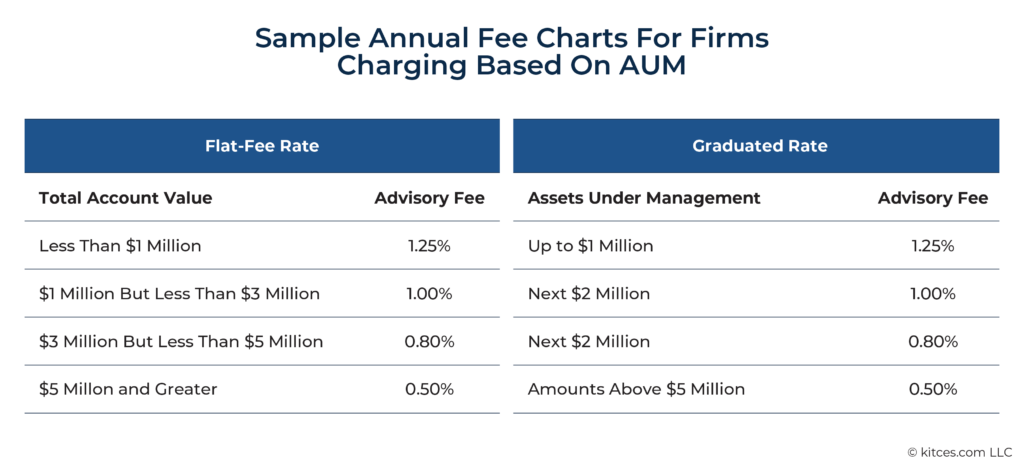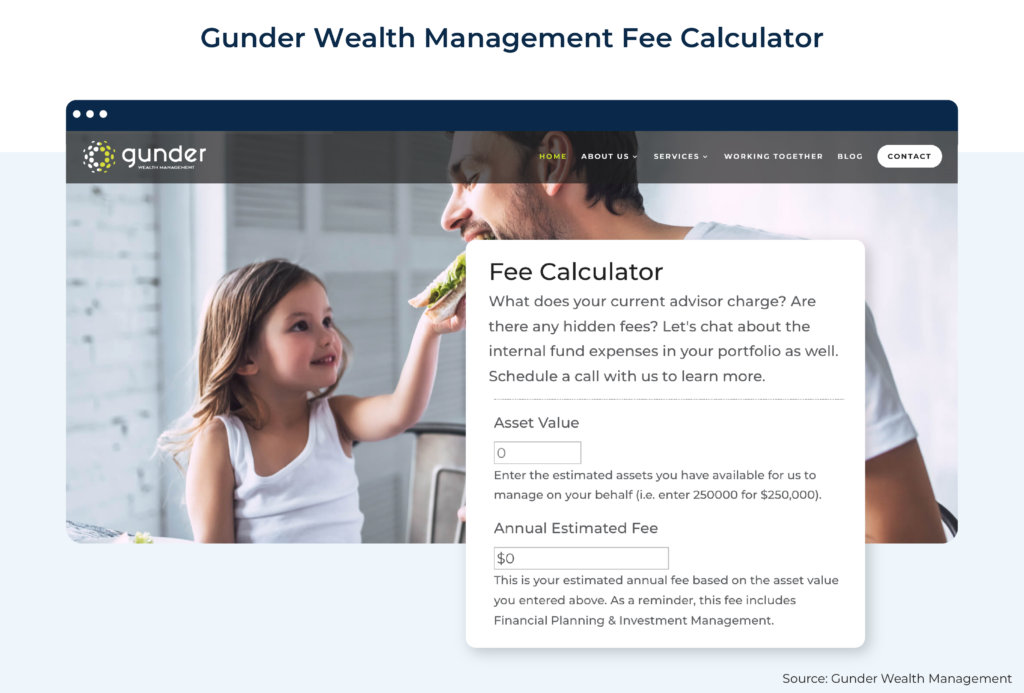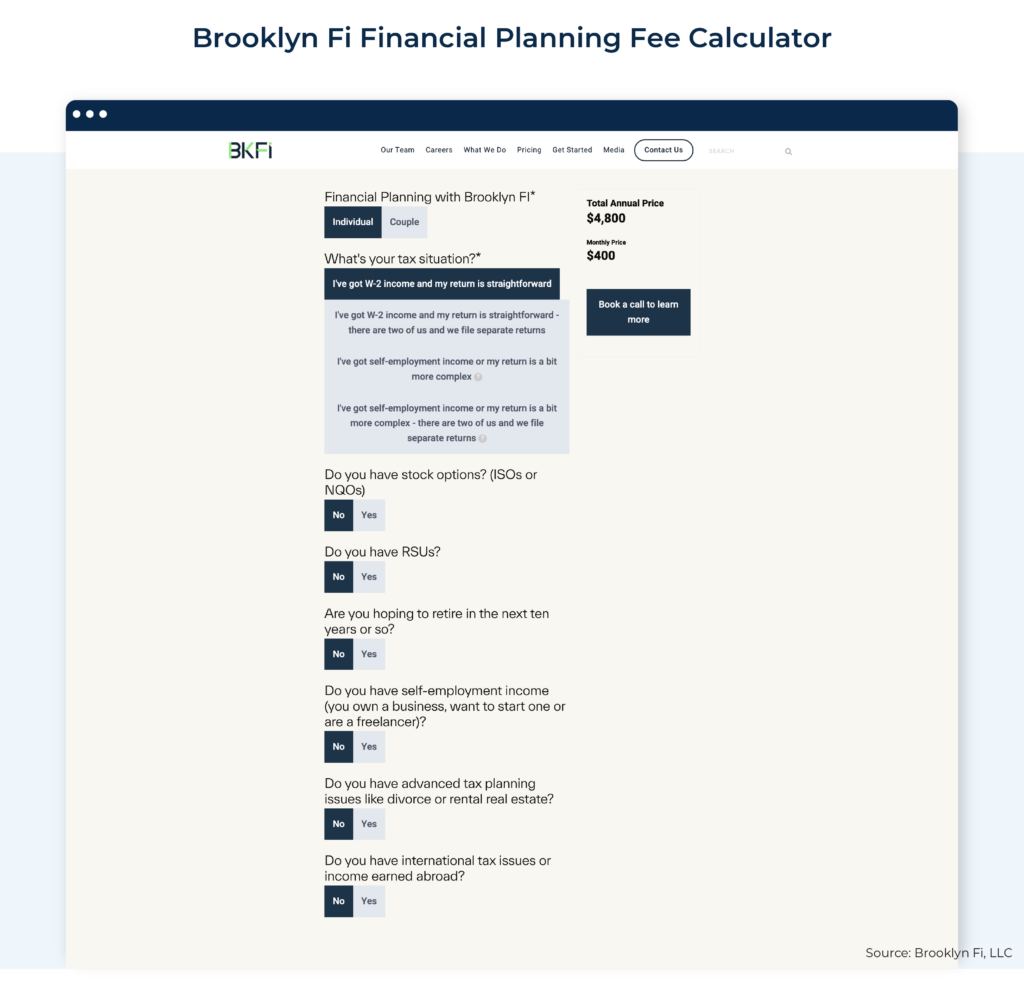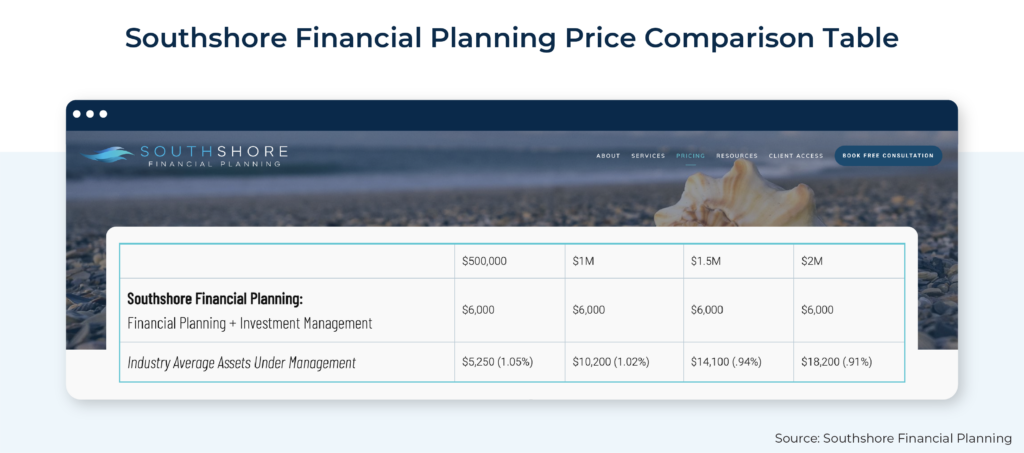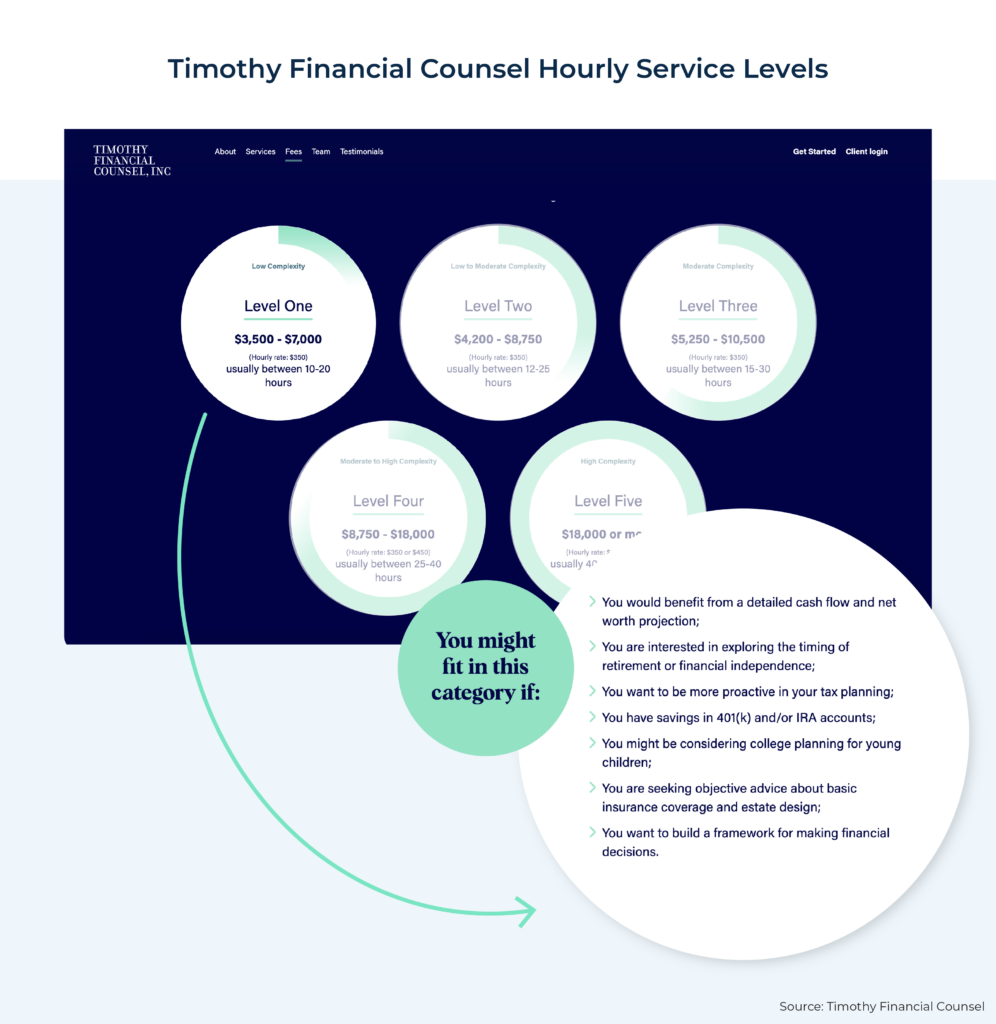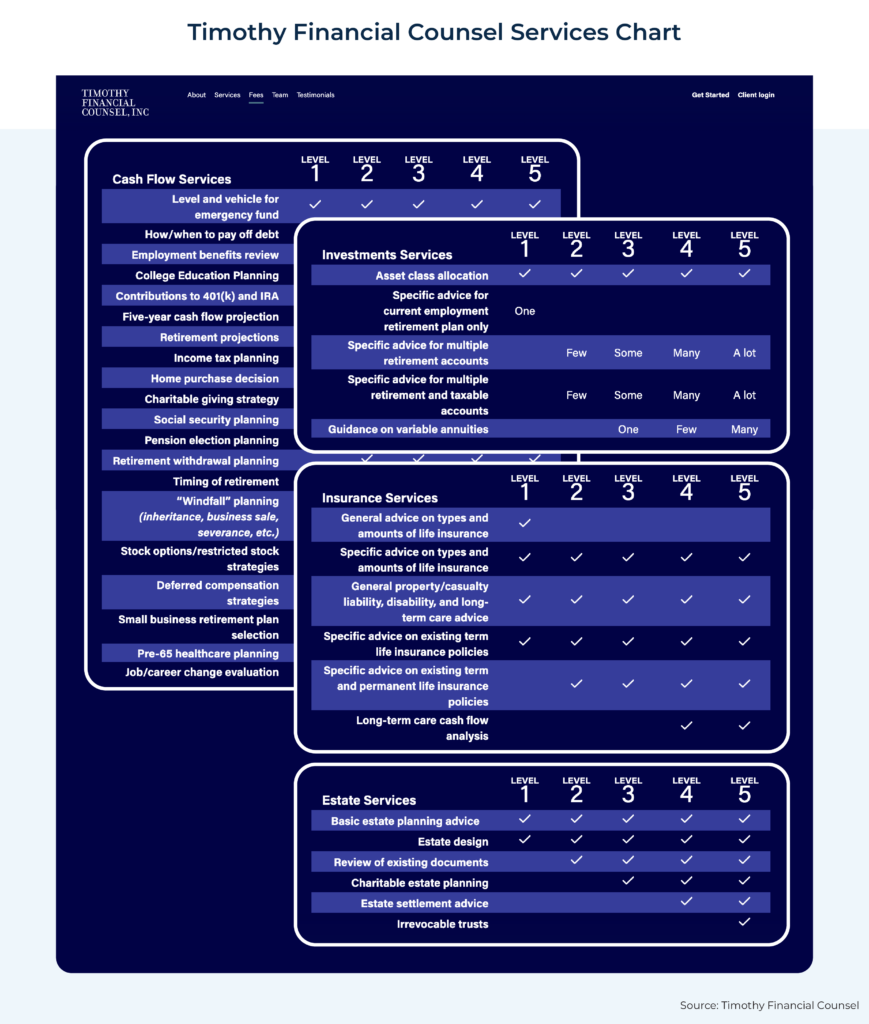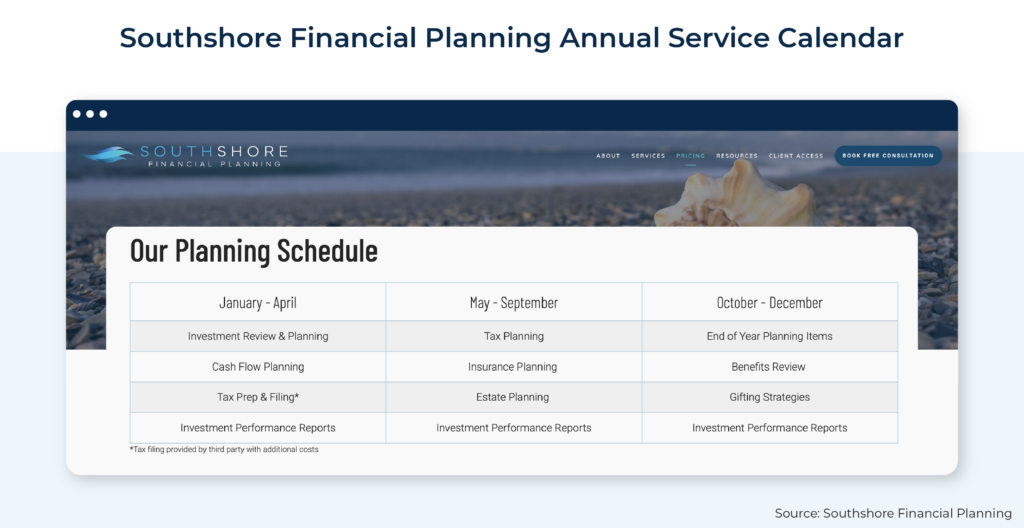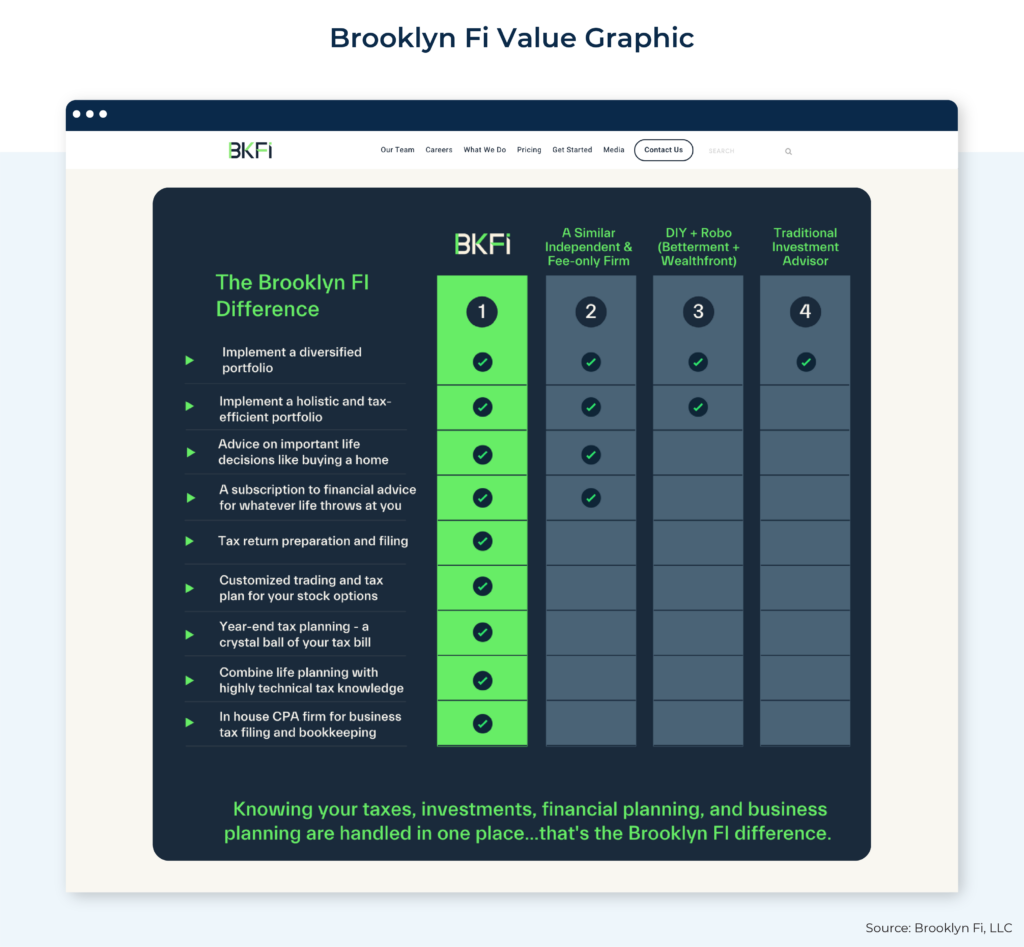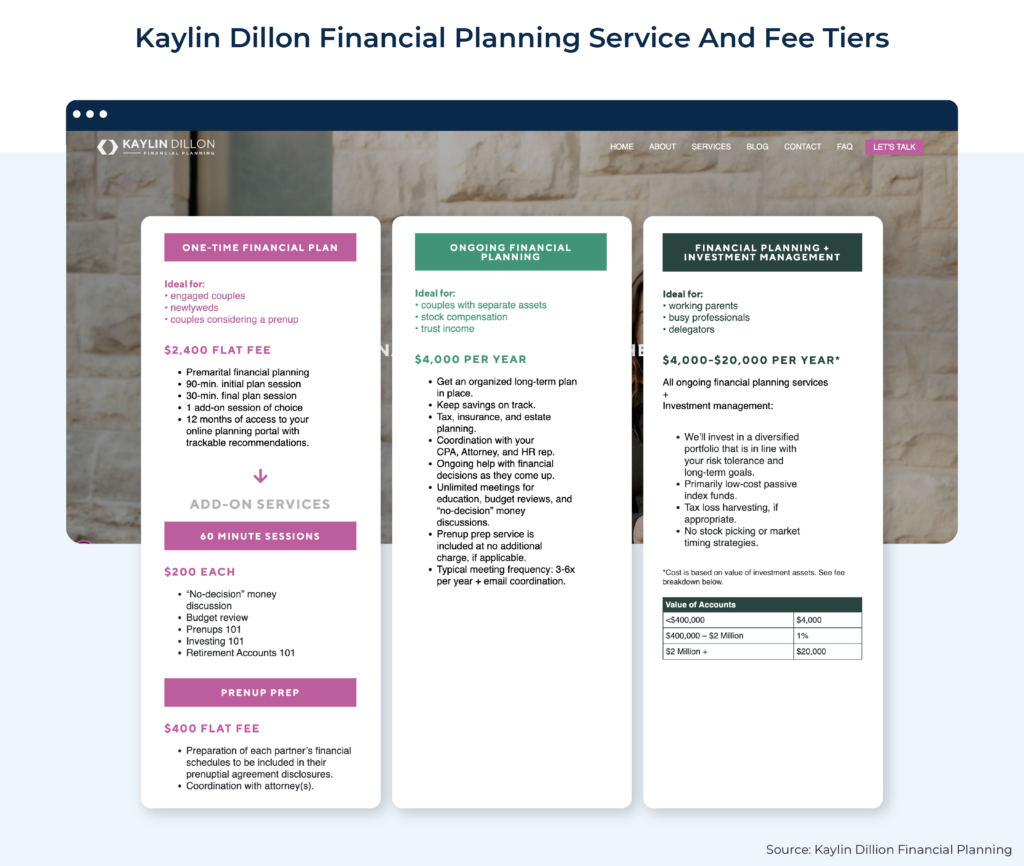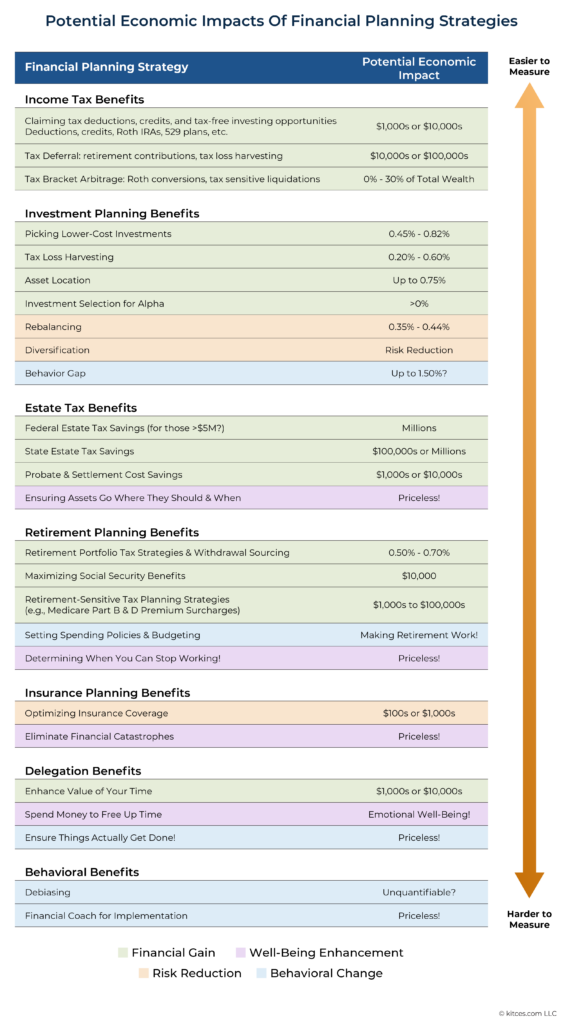Executive Summary
When a prospect is looking for a financial advisor, understanding how much they will need to pay can often be a tricky proposition. In part, this is due to the many commission-based advisors whose compensation depends on the sale of insurance or investment products, where the price that a client pays is baked into the price of the product or is included in (often opaque) fees associated with buying, selling, and/or holding the investment. But even as fee-only financial planning has gained in popularity and advisory firm websites have become ubiquitous, it can still sometimes be hard for prospective clients to determine how much they would pay for advice before actually reaching out to the firm. But by listing fees on the firms' websites in a transparent manner (no matter their fee model) and linking their fees to the value they offer, advisors can provide prospects with a better idea of whether the firm is a good fit, potentially leading to a higher conversion rate of prospects into clients.
Financial advisory firms have a wide range of options when it comes to displaying their fees on their website. For instance, firms charging on an Assets Under Management (AUM) basis can provide a chart (or even a calculator!) that connects a prospect’s assets with the percentage fee they would pay as a client. A firm with a retainer fee model might show what a prospect’s expected fee would be based on their individual circumstances and the criteria the firm uses to determine its fee (e.g., the complexity of the prospect’s financial situation). And firms that charge on an hourly basis can provide their hourly fee(s) and the estimated number of hours it will take to work with a client based on their particular circumstances.
Given that comprehensive financial planning is not a commodity service where consumers might make a choice on price alone, advisors also have the opportunity to use their website to demonstrate the unique value they provide to clients. And by showing prospects in advance of the initial discovery call how their specific financial planning needs will be met, advisors enable them to come to the call with a better understanding of the firm and what it offers, allowing them to prepare more specific and relevant questions about the planning process. This can be accomplished in a variety of graphical means, from a table comparing the firm’s service offerings with those of other types of advisors to a client service calendar that shows prospects the work the firm will be doing on their behalf once they become clients.
Ultimately, the key point is that because an advisor’s website often serves as the first touchpoint for prospective clients, it is an important tool to help explain the types of clients with whom the firm works and the value the firm provides. And by using the website to clearly communicate the information needed to help visitors understand the value the advisor provides as well as the fees charged, advisors can attract prospects who would be ideal clients for their firm!
It is usually not a challenge for consumers to find the prices of most goods and services, and the internet has made doing so even easier. But when a consumer is looking for a financial advisor, understanding how much they pay can often be a tricky proposition. In part, this is due to the many commission-based advisors whose compensation depends on the sale of insurance or investment products, where the price that a client pays is baked into the price of the product or is included in (often opaque) fees associated with buying, selling, and/or holding the investment. This can give clients the impression that they are getting financial advice for ‘free’ because the fees they are paying (which they don’t even realize they are paying) aren’t made explicitly to their advisors.
But even as fee-only financial planning has gained in popularity and advisory firm websites have become ubiquitous, it can still sometimes be hard for prospective clients to determine how much they would pay for advice before actually reaching out to the firm. Some fee-only firms do not publish their fees on their website (often preferring to discuss it during a prospect meeting), while others display their fees in a way that makes it hard for prospects to understand how much they will pay for the firm’s services. But by displaying fees on their website in a transparent manner (no matter their fee model) and linking their fees to the value they are providing, advisory firms can provide prospects with a better idea of whether the firm is a good fit, potentially leading to a higher conversion rate of prospects into clients.
How Listing Fees On Websites Can Benefit Advisory Firms
For clients, one of the attractive aspects of working with a fee-only advisor is the transparency of the fees they are paying. Whether an advisor is charging on an Assets Under Management (AUM), retainer, project-based, hourly, or other fee-only model, when compared to commission-based models, it is much easier for clients to understand not only how they are being charged but also the dollar amount they are paying for the advice they receive. And understanding how and what advisors charge (and the value they are providing) can help those looking for an advisor understand which might be the best fit for their individual needs and financial situation.
Notably, RIAs are required to disclose their fee schedule in Item 5 of their Form ADV Part 2A, which is available to the public on the SEC’s Investment Adviser Public Disclosure website. While accessible, searching for a firm of interest and finding the fee schedule within the ADV document can take time for prospective clients (in the possibly unlikely event that they know what an ADV is in the first place). Which has led many firms to disclose their fees on their website, not only to increase transparency to prospective clients but also to attract prospects who would be a good fit for the firm.
For example, firms that saw the greatest new client revenue growth in 2021 were more likely than other firms to include pricing information on their website, according to unpublished data gathered for the 2022 Kitces Research Study On How Financial Planners Actually Market Their Services. Among respondents, 45% of firms that experienced 30% or greater new client revenue growth posted their fee schedule on their website, while only about 21% of firms that saw 5% to 9% new client growth did so. Further, across all firm sizes (in terms of total revenue), high-growth firms were more likely to include their fee schedule on their website than other firms.
At the same time, while RIAs are required to disclose their fees in the firm’s ADV, some firms are reluctant to publish their fee schedules as well as asset and/or fee minimums on their websites. Some firms may prefer to show their value during an introductory prospect meeting before discussing their fees, while some may want to discourage prospects from ‘price shopping’ for advisors (as a consumer might discount the value of a higher-priced advisor, even if they provide a more appropriate level of service for their needs than a lower-priced offering).
Nevertheless, for firms who choose to do so, displaying fees and minimums on their website in a clear manner that links to the value being provided can benefit not only by potentially leading more clients to reach out to the firm but also by reducing the time advisors spend discussing fees or meeting with unqualified clients.
Setting Prospect Expectations
Unlike many goods and services whose prices are well known and frequently advertised (e.g., a consumer will know about how much they might have to pay for a new television), many individuals looking to hire a financial advisor have little (if any!) idea as to how (or how much) advisors charge for their services, and many might not be familiar with the range of services an advisor might provide.
When a consumer comes to an advisor’s website, they often search for 3 things: 1) the services the advisor provides (i.e., what value the firm offers), 2) whether the firm works with people like them (i.e., whether they meet the firm’s asset and/or fee minimums and whether the prospect is in the firm’s target niche), and 3) how much working with the advisor will cost. Notably, consumers are not the only ones reviewing advisor websites; potential referral sources – whether a center of influence (e.g., lawyers and accountants) or a current client – may want to make sure the firm is a good fit for the person they are referring to avoid the referred prospect later finding out that they do not meet the firm’s asset and/or fee minimums (which could change over time).
Further, allowing consumers to better understand a firm through its website makes it more likely that they will actually follow through and reach out to the firm. As while an individual might be reluctant to contact an advisor or schedule an introductory meeting if there’s a chance that they won’t meet the firm’s minimums, they would be more likely to reach out if they have a way to confirm in advance that they would be a good fit in terms of fees and the services provided.
In addition, by providing prospects with fee and asset minimum information up front, advisors can save themselves time by increasing the likelihood that they will only meet with qualified prospects. This can also allow the advisor to focus more time during discovery meetings listening to the client’s needs and discussing the value the firm provides, avoiding the potentially awkward discussion of asset minimums with prospects who do not meet them.
Nerd Note:
One way to further encourage prospects to view a firm’s fee and/or asset minimums is to require prospects to acknowledge that they have reviewed this information before scheduling an introductory call. This question can be included in the firm’s meeting scheduling interface (e.g., Calendly or OnceHub) to reduce the number of unqualified candidates from scheduling appointments.
Confronting Anchoring Bias
While some prospective clients might not know what financial advice may cost, others might come to an advisor’s website with certain price expectations, perhaps from their previous experience working with an advisor. The phenomenon of anchoring bias, which occurs when an individual relies too heavily on the first piece of information they are given about a topic, can cause some prospects to reconsider reaching out to the advisor for more information. For example, if a consumer currently uses a robo-advisor and pays a 0.25% AUM fee, the robo-advisor’s fee could serve as an ‘anchor’ as they evaluate fees for other advice options. This highlights the importance of explaining the advisor’s value proposition and why it is superior for their target client compared to lower-cost options in order to help overcome anchoring bias.
Altogether, advisory firms and consumers can both benefit when fees and minimums are included on a firm’s website, particularly when they are easy to find and linked to the value that the advisor provides. And given that one of the selling points of fee-only financial planning (compared to commission-based fee models) is transparency between advisors and clients, being clear about fees and minimums up front can help begin building trust between a prospect and the advisor from the start of the relationship!
How Firms Can Display Advisory Fees In An Effective Manner
Financial advisory firms have a wide range of options when it comes to displaying their fees on their website. The key, though, is to explain fees (and minimums) in a clear and transparent manner that links the fee to the value the advisor provides, giving prospective clients a reasonable idea not only of what they might pay working with the advisor but, more importantly, of the value that they will receive.
While some parts of a firm’s fee structure might be complicated (e.g., combining a retainer fee with an AUM-based fee), being clear upfront about asset or fee minimums is a simple way to save time for both the prospect (who won’t have to spend time contacting the firm and/or sitting through a meeting only to find out they are unqualified) as well as for the firm (which won’t have to spend time meeting with unqualified prospects).
With the firm’s minimum fee or assets established, the next opportunity is to display their fees clearly. Given the wide range of fee models used by advisors, there is no single best way to do so, but firms and prospects can benefit when website visitors are able to get a ballpark understanding of what they might pay.
How Firms Charging On An AUM Basis Can Display Their Fees
Charging fees based on a client’s Assets Under Management (AUM) remains a popular fee structure among fee-only advisors. According to the 2022 Kitces Research study on How Financial Planners Actually Do Financial Planning, AUM fees represented more than half of revenues for 82% of advisors participating in the study. At the same time, there can be nuances within the AUM fee structure that can make it hard for prospects to understand how much they will be charged.
For example, firms that charge on an AUM basis might charge a flat-fee rate (where a single rate is applied to all assets and will change as the portfolio value rises above or falls below certain thresholds) or a graduated rate (a blend of different fee rates across graduated AUM tiers, e.g., 1.25% for the first $1 million in AUM and 1% on the next $1 million). But given that the rate charts of each of these fee structures can look similar, being clear about which rate style is being used can help clients better understand how much they will actually pay.
In the fee schedules below, the AUM tiers are similar in terms of both assets and the rate charged, but key differences in language can help prospective clients understand which type of schedule the firm uses. For example, a firm using a flat-fee rate might want to use a phrase such as “Total Account Value” to signal that the rate in the chart is being charged based on the total AUM rather than on a graduated basis. For firms that use a graduated basis, discussing assets “Up To” a certain amount (for the first fee tier), followed by the “Next” asset tier, can help show that the first tier of assets is still charged the higher rate, while the next tier is charged a lower rate.
Notably, when firms use charts similar to the above, prospects still need to do the math to figure out how much they would pay in fees. While this calculation is fairly simple for firms charging flat-fee rates (as the prospect only needs to multiply their assets by the single rate tier for their given asset level), it can be more complicated when graduated rates are being used (as a prospect would have to calculate the fee associated with each asset/rate tier and add them up). Either way, examples can help prospects understand how the fee is calculated.
Which means a firm using the flat-fee rate chart above might use the following example:
Audrey and Jerome have $2.5 million in combined assets that will be managed by our firm.
Therefore, their flat-fee rate will be 1%, and their annual fee will be $2.5 million × 1% = $25,000.
A firm using the graduated rate chart above might use this example:
Audrey and Jerome have $2.5 million in combined assets that will be managed by our firm.
They will pay $1 million × 1.25% = $12,500 on their first $1 million in assets and $1.5 million × 1% = $15,000 on their remaining assets, for a total annual AUM fee of $12,500 + $15,000 = $27,500.
To make it even easier for prospects to estimate their fee, firms can provide a calculator that incorporates the firm’s rate schedule. For example, Michigan-based RIA Gunder Wealth Management includes the following fee calculator on their website (built using the Calculated Fields Form plugin through WordPress) based on their rate schedule:
Instead of having to decipher a chart and run calculations themselves, a prospect can instantly get an estimate of their annual fee, preventing confusion and potential errors.
How Firms Charging On A Retainer Basis Can Display Their Fees
According to the 2022 Kitces Research study on How Financial Planners Actually Do Financial Planning, 39% of respondents use retainer fees (though only 3% relied on them exclusively to generate revenue). Firms that charge on a retainer basis (whether or not in conjunction with an AUM fee) have a variety of ways to display their fee. While some of these are rather simple (e.g., a single flat annual or monthly fee for all clients), other firms have more complex calculations based on the client’s individual financial situation. For the latter group, while it might not be possible to provide their exact expected fee on the firm’s website, providing tools to help prospects get a ballpark estimate can allow them to have a better idea of how much they would pay and whether the firm might be a good fit.
For example, New-York based RIA Brooklyn Fi charges for financial planning services based on the complexity of the client’s situation. On their website, they include a calculator that lets prospects estimate their annual fee based on their unique circumstances. It starts out at the firm’s minimum annual planning fee ($4,800) and increases based on factors that make the prospect’s situation more complicated (e.g., having stock options or their own business).
While the calculator does not cover every potential circumstance that could contribute to a client’s fee, it establishes the firm’s minimum fee and gives the prospect a general idea of how much they might pay (so that it is not a complete surprise when the final fee is discussed during discovery meetings).
Firms with other retainer fee structures can create similar calculators incorporating their unique fee inputs, whether it is the prospect’s income, net worth, or other characteristics.
Also, as a relatively newer fee model (at least compared to commission and AUM-based models), firms that use a retainer model could be more susceptible to anchoring bias among consumers who might be used to different types of fee structures. But this bias can potentially work in these firms’ favor, as their offering might actually be less expensive than another model, depending on a prospect’s particular situation.
For example, Florida-based RIA Southshore Financial Planning typically charges clients $6,000 per year for financial planning and investment management services. On its website, it compares this fee to what prospects with varying assets might be charged working with a firm charging on an AUM basis. Demonstrating transparency, it shows that while clients with significant assets might pay less with Southshore, those with lower assets might pay a lower fee at an AUM firm.
Notably, firms using other pricing models could use a similar chart to compare their fees to other models. Though given that financial advice is not a commodity (where a consumer might make a choice on price alone), it is still up to the firm to demonstrate how its client service proposition (perhaps in tandem with its fee) makes it an attractive offering for a given prospect.
How Firms Charging On An Hourly Basis Can Display Their Fees
According to the 2022 Kitces Research study, 40% of advisors derive at least some revenue by charging on an hourly basis. And while publishing a firm’s hourly rate on its website can give clients a better idea of how much they will pay for the firm’s services, this is only half of the equation, as the prospect might also want to know how many hours the advisor will need to cover the prospect’s particular situation to get an idea of the total cost.
Illinois-based RIA Timothy Financial Counsel charges clients on an hourly basis, and its website is transparent both in terms of the hourly rate charged and the typical amount of time needed for planning services given a client’s particular needs. This is done through a 5-level scale, where Level 1 represents the clients with the least complicated situations, and Level 5 represents clients with the most complex circumstances. Website visitors can click on each level for a list of the typical client circumstances for that service tier.
So while the firm can only give a firm fee quote after an introductory meeting (during which the advisor and the prospect discuss the appropriate complexity level for the prospect), Timothy Financial Counsel’s website gives prospects a reasonable estimate of how much they might pay for the firm’s hourly services.
Notably, this is not a comprehensive list of advisory firm fee structures. For example, some firms charge on a project basis, with either a flat or complexity-based fee. But no matter how an advisory firm charges, similar principles apply – giving the prospect a better idea of what they can expect to pay and displaying the value the prospect can expect to receive for that price also allows them to better understand how the advisor’s services will (more than) justify the fee they charge.
How Firms Can Link Their Unique Value To Their Fees On Their Website
Given that comprehensive financial planning is not a commodity service, advisors have the opportunity to use their website to demonstrate the unique value they provide to clients. By showing prospects how the advisor will meet their specific financial planning needs (and whether they qualify from a fee/asset minimum perspective), prospects will come to a discovery call with a better understanding of the firm and what it offers.
For example, Timothy Financial Counsel publishes a chart on its website that shows not only the wide range of services it provides for its clients (from cash flow planning to investment services) but also the specific services clients can expect to receive based on their service level (which is correlated to the hourly fee they pay and the hours it takes to complete their plan).
For firms that offer ongoing planning (e.g., for an annual AUM or retainer fee), prospects might be curious about the value they will receive once their initial plan is created. This can be an opportunity for firms that use a client service calendar to post it to their website to let prospects know what services they can expect to receive throughout the year if they become clients.
For instance, Southshore Financial Planning’s website explains how the firm meets with clients 3 times per year and includes a graphic that shows what topics are covered in each meeting.
Displaying the firm’s specific value proposition can also be a way to differentiate its value proposition from other advisor types. For instance, Brooklyn Fi includes a graphic on its website that compares the services it offers to a generic fee-only firm, robo-advisors, and a traditional investment advisor. While the image shows that all 4 advisor types can implement a diversified portfolio, there are other areas that are only provided by human advisors engaging in comprehensive planning (e.g., advice on important life decisions like buying a home).
The comparison also highlights the specialized areas of focus for Brooklyn Fi that are less common with other fee-only firms, including tax return preparation and filing and a customized trading and tax plan for clients’ stock options. The key point is that while prospects might be able to receive advice for a lower cost from other advisor types, Brooklyn Fi is able to demonstrate its unique value for its target client types.
While some advisors offer a single service tier for clients, others offer multiple options. By being clear about these tiers on the firm’s website, advisors help clients understand not only which service would be the best fit for them but also how the advisor’s fee matches its service proposition.
For example, the website for Kansas-based RIA Kaylin Dillon Financial Planning shows the 3 service levels for clients: a one-time financial plan, ongoing financial planning, and financial planning combined with investment management. It shows the ideal client types for each service as well as the specific services offered at each level, helping prospective clients better understand where they might fit best.
Further, the firm’s website makes it easy for prospective clients to understand how much they will pay for services, whether they opt for the flat fee charged for a one-time plan or for ongoing financial planning, or for the AUM-based charge for financial planning and investment management.
In addition to demonstrating the firm’s specific value proposition, firms can also consider citing research studies that have estimated the dollar value of financial advice, including Vanguard’s Advisor’s Alpha (which found advisor value can add up to approximately 3% in net returns), Morningstar’s Gamma (which found that advisors can potentially improve an average investor’s returns by approximately 2%), or Envestnet PMC’s Capital Sigma (which found that advisors produce an annual portfolio value-add of around 3%).
While the planning areas and results of these studies vary, they show that advisory clients generate more financial value from their advisor than they typically pay in fees (notably, these studies focus on quantifiable factors, whereas advisors also provide behavioral benefits and can save clients time by allowing them to delegate planning tasks).
For instance, the following graphic from the 2015 Kitces Report: Evaluating Financial Planning Strategies And Quantifying Their Economic Impact summarizes the data on the potential economic impacts of financial planning strategies for clients. While not showing the exact value provided to a given client, such a graphic can provide prospects with a ballpark idea of how much they could benefit from working with the advisor (with the dollar benefits often exceeding the advisor’s fee alone!).
Altogether, advisors have a variety of ways to demonstrate their value both in absolute terms (using research on the dollar value of advice) as well as in relative terms (showing how their firm’s unique value proposition compares to other types of financial advice)!
Ultimately, the key point is that because an advisor’s website often serves as the first touchpoint for prospective clients, it is an important tool to help explain the types of clients with whom the firm works and the value the firm provides. And by using the website to clearly communicate the information needed to help visitors understand the value the advisor provides as well as the fees charged, advisors can attract prospects who would be ideal clients for their firm!


